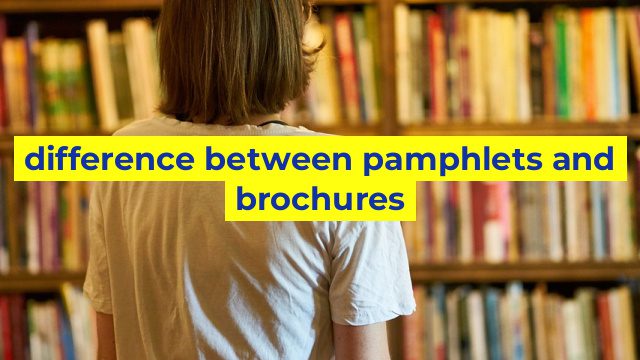The Difference Between Pamphlets and Brochures: An Essential Guide
When it comes to marketing and promoting products or services, there are several methods to choose from, including pamphlets and brochures. These two terms may seem interchangeable at first glance, but they have distinct differences that can affect their effectiveness in achieving your marketing goals. In this article, we’ll explore the differences between pamphlets and brochures to help you make the right choice for your business.
The Definition of Pamphlets
A pamphlet is a type of single-sheet document that contains information on a particular topic. It is usually printed in a small size and can be folded in various ways. A pamphlet often serves as a promotional tool for businesses, organizations, or political campaigns. Some common uses of pamphlets include:
– Advertising products or services
– Providing instructions or guides
– Delivering political or social messages
– Distributing news updates
Pamphlets can contain a lot of information in a small space, but they are often limited to just one topic or message. They are also designed to be easy to distribute and can be handed out in person, mailed, or left in public spaces like grocery stores or libraries.
The Definition of Brochures
A brochure, on the other hand, is a type of booklet that contains information on a specific product or service. Unlike a pamphlet, a brochure is usually more detailed and contains more images or graphics to help promote the product or service. A brochure often includes detailed information on features, pricing, and benefits of the product or service.
Brochures are designed to be visually appealing to the reader, and they often come in a variety of sizes, ranging from a simple trifold to a multipage booklet. They can be used to promote a range of products or services, including:
– Travel destinations
– Real estate listings
– Menu items for restaurants
– Health care services
While brochures are often more expensive to produce than pamphlets, they can be an effective tool for a business or organization with a specific product or service to promote.
The Main Differences Between Pamphlets and Brochures
Now that you have a clear understanding of what pamphlets and brochures are, let’s take a look at the main differences between them:
1. Purpose: Pamphlets are typically used to promote a specific message, service, or product, while brochures are often used to provide in-depth information about a product or service.
2. Format: Pamphlets are usually single sheets of paper, while brochures can be multiple pages and come in a range of sizes and folds.
3. Content: Pamphlets are typically more focused on delivering a single message or idea, while brochures contain more detailed information on a specific product or service.
4. Design: Pamphlets are often designed to be simple and easy to read, while brochures are designed to be visually appealing and draw the reader in with graphics and images.
Overall, both pamphlets and brochures can be effective marketing tools, depending on what you’re trying to achieve. If you have a more in-depth product or service to promote, a brochure might be the best choice. If you’re looking to promote a specific message or idea, a pamphlet could be the better option. By understanding the differences between these two types of marketing materials, you can make an informed decision and achieve your marketing goals more effectively.
Table difference between pamphlets and brochures
| Pamphlets | Brochures | |
|---|---|---|
| Definition | A small booklet or leaflet containing information about a single subject or topic. | A promotional document that provides information about a product, service, or organization. |
| Size | Smaller in size | Larger in size |
| Content | Provides general information and is more informative in nature. | Focuses on specific products or services and is more promotional in nature. |
| Design | Usually simple and straightforward design. | Complex and visually appealing designs. |
| Usage | Can be used for educational, informational or promotional purposes. | Primarily used for promotional purposes. |
